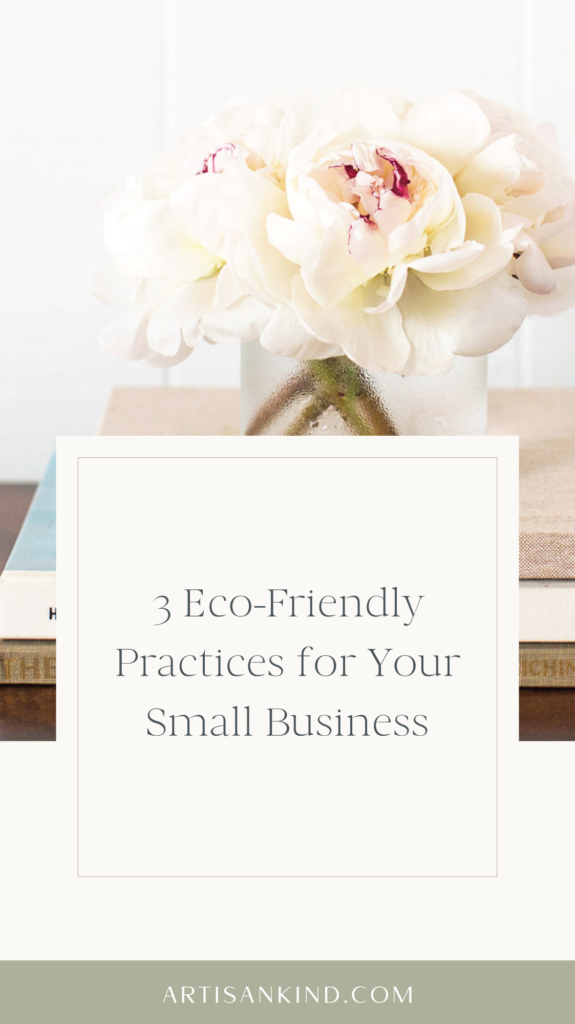browse Business tips
explore my work
Categories
Expect small business, branding, and website tips, client website and brand projects, and occasional recommendations that help you build a life you love while growing your business — one filled with joy.
WELCOME TO THE WEB DESIGN + BRANDING BLOG FROM ARTISAN KIND
When we consider eco-friendly choices we don’t often think about the impact of our online activities.
We usually think about things like recycling, using less plastic, or going paperless (aka..moving to more sustainable digital options). But those digital alternatives also come at a cost.
But guess what? There’s so many little steps we can take to make a difference in our day to day.
In my first graphic design role out of college I realized that our company left a lot of paper waste behind and I wondered why we didn’t recycle.
You know what I did?
I asked. And they were so surprised! In their day to day of running the business it wasn’t a step that ever really crossed their minds. We immediately made a plan to start doing better and it was a great feeling.
As business owners there are just some things that leave a carbon footprint in ways we may never even have realized.The emails we send and receive, the meetings we have with clients, google searches, and cloud storage all affect our carbon footprint.
So let’s chat. Let’s learn together about a few ways we can be more conscious of our internet usage in business so that we can all live a little gentler on this earth.
“The greatest threat to the Earth is believing someone else will save it”
– Robert Swan

Choosing an eco-friendly platform: Zoom vs Google Meet
Since 2020 we’ve all become pretty comfortable on video conferencing platforms (the usual call jitters aside of course). Our calendars have been filled with discovery calls and project meetings.
But did you know that the time we spend video chatting for business can have an environmental impact?
Zoom and Google Meet are two of the most common platforms used for video conferencing, but is there a difference? (The answer is yes!) So let’s take a look:
First we have to understand the role of “servers.” In tech terms, a server is a piece of computer software that allows other programs (like Zoom and Google Meet) to function.
Think of the server as soil and the program as a plant. The plant won’t grow without the soil and the type of soil can affect how that plant grows.
Every server is fueled by energy. The type of energy used to fuel it dictates what kind of environmental impact it will have.
Zoom:
A recent study breaks down the CO2 emissions of a typical Zoom meeting. Zoom as a company keeps the details on emissions pretty loose without any hard and fast data. This calculator was created based on the study to help users understand what their daily and weekly meeting activities equated to in terms of emissions from driving in a car.
For example:
If you meet for a 1-1 call with clients for a total of three hours a week… that is the equivalent of driving 0.12 miles a week in a car.
Now you might be saying: “that certainly beats commuting to work for meetings” and you’re 100% right. But every week, every person who works over Zoom… that 0.12 equivalent can add up fast.
Go ahead and plug your own weekly stats into the calculator to have a look!
Google Meet:
Google as a company has been moving towards more eco-friendly ways of powering their systems and has been carbon neutral since 2007. They are working towards being carbon free by 2030.
How are they doing this?
Renewable energy sources.
Google is incredibly open about all the ways they are reducing their carbon footprint. Their servers are run on solar, nuclear, and wind powered energy.
That includes all your favorite tools:
- Google drive
- Sheets
- Docs
- Calendar
- And yes, Google Meet
Perhaps you’ve been a Zoom-er since the beginning (and that is 100% okay!)
I made the switch from Zoom to Google Meet when I realized that a 1 hour meeting with a client left zero traces of carbon emissions. This one action alone does not change the world (not by any means), but it’s a small step that again, can add up over time.

Creating an eco-friendly website and social media account
Did you know there’s one often overlooked step that you could implement right now to be more eco-friendly on your website and your social media pages?
Compressing your image sizes.
Now what exactly does that mean?
You may already know that images on your website can drastically impact website page functionality and loading speeds. More time to load an image means (you guessed it) more energy and CO2 emissions from your website server.
It’s a hard compromise when visuals are what pull an audience in, right? So how do we create images that are more efficient and more kind to the earth?
Compressing an image size doesn’t literally mean sizing up or sizing down to make it appear smaller. It is simply minimizing the size of the file (PNG, JPEG etc.) without degrading the quality of the image.
When you compress an image it allows for more images to be included on your page without the same storage or environmental drawbacks.
You can easily do this by adding your images to a free online tool like TinyPNG first before uploading them to your website or to your social media platforms. Just like your website, your favorite social platforms all run on energy draining servers.
Engaging in eco-friendly content
Every click. Every scroll. Every post. It matters.
You’re no stranger to content (and you may associate a few choice feelings with the term). What you may not associate with content is the environmental impact every click can have!
Just today you may have sent an email, opened an email you received, shared a post to instagram, or uploaded a new video. Perhaps you did so on your business accounts or your personal ones.
This study by Earth.org shows that all of our devices where we engage in these social activities accounts for 3.9% of all global greenhouse emissions. Which for reference, is greater than that of the aviation industry.
Hard to wrap your head around right?
So what do we do about this when social media and content creation are necessary to connect with our audiences?
A few suggestions:
- Unsubscribe from email lists you aren’t actively engaged in
- Focus on posting quality content that will actually resonate with your audience and make that click to post truly worth it
- Avoid posting fluffy content for the sake of “showing up” in your feeds
- Limit the scrolling time on social media
- Consider compressing images
- Consider if the content you’re sharing has to be long or if you’re point could be made in a shorter format
- Post while on Wifi vs data
It’s all about conscious effort and taking a second to clear away the unnecessary from our space. Besides being kinder to the earth, these actions can also help to reduce your stress level surrounding the clutter, chaos, and immense time commitment that goes into engaging in the content sphere.

Bringing it all together
With countless tips out there on how to be more eco-friendly in your life and in business it can get a little overwhelming. It can make us feel guilty for not doing enough.
I’m here to tell you that there is no need to feel guilty. Or to overwhelm yourself by doing all the things, by making all these changes right now.
I challenge you to take a step back and look at your unique situation…is there a single thing that you could be more conscious of today?
Is it working to switch your meeting software over to a more sustainable option such a Google Meet instead of Zoom?
Could it be uploading a few images to TinyPNG to compress their file size (a help to the earth and your user experience).
Maybe it’s simply unsubscribing from that email list you always delete without opening.
Here’s my secret: You don’t have to be perfect to make eco-friendly choices, every consciously kind act makes a difference.
Every single one.
Download my step-by-step guide to crafting an enticing lead magnet so you can attract, nurture, and convert an interested audience into ideal clients.
Lead your audience from loyal follower to interested audience member to future client.
Let's create a website you'll be excited to send them to.
YOUR NEW WEBSITE + BRAND AWAITS
Let’s invite them in, so they can experience the joy of working with you.
Are you ready for a website that shares your magic with the world?
proudly designed in my 100% solar powered home studio
ARTISAN KIND LLC © 2024
proudly designed in my 100% solar-powered design studio | ARTISAN KIND LLC © 2025
Head Home
Meet your Designer
View Portfolio
Get In Touch
Book Discovery Call
Explore All Services
Custom Webs Design
Semi-Custom Web Design
Custom Brand Design
Shop Website Templates
Browse Favorite Resources
Free Website Assessment
Explore the Blog
Read Terms & Privacy Policy
Find Your Way Around
Small business and website tips, branding advice, client projects, and occasional recommendations that help you build a life you love while growing a more joy-filled business.
Email Community
join the
Every element of my website, copywriting, and designs has been thoughtfully crafted by real human hands and creative minds, ensuring your experience is personal, intentional, and authentically human!
An authentically human experience
Aubre Walther is a Showit Designer based in Eau Claire, WI, serving clients worldwide from a 100% solar-powered home design studio.
Creating websites & brands that make your potential clients feel an instant sense of connection and trust.
